OVERVIEW
This is the final stage of the Wexford-Pembrokeshire Pilgrim Way, from Whitesands to St Davids. Begin at the hidden remains of St Patrick’s chapel on a raised mound to the east of the bay, said to be from where St Patrick set sail to begin his journey to Ireland. Follow the coast path from Whitesands to St Justinians, who was St David’s confessor and see the ruined remains of St Justinian’s Chapel (on private land) overlooking Ramsey Island.
Follow the coast path and the racing tides through Ramsey Sound past the treacherous outcrop of rocks known as The Bitches, reputedly created by St Justinian himself with an axe whilst cutting away Ramsey Island from the mainland. Once around Ramsey sound you will follow the coast path to Porthlysgi Bay, named after the Irish sea pirate, a great warrior said to have killed the local Celtic Chieftain at Clegyr Boia.
The coast path will then take you to the Porthclais harbour where you can discover what is thought to be St David’s Baptismal Well at Ffynnon Ddewi. The path then continues to St Non’s bay, the birth place of St David. Here there is the site of the remains of St Non’s Chapel, magical pagan circles and standing stones, St Non’s well and a small new Catholic chapel built in what was thought to be the same style as the ruined St Non’s Chapel.
From St Non’s it is a short walk inland following the river Alun passing the ruins of the Bishop’s Palace to the great reveal of St David’s Cathedral. On arriving at the Cathedral, make your way to the shrine of St David, the final destination.
HIGHLIGHTS / PLACES OF INTEREST
St Justinians
St Justinian’s Chapel is now on private land but can be seen just above the RNLI centre. This structure is mostly 16th-century but it is thought it may conceal ruins many centuries older. This was an important destination for medieval pilgrims.
St Justinian was St David’s confessor and there are many legends about him. He was thought to have been very strict and considered St David to be too lax with the monks. He therefore took himself off to Ramsay Island with some loyal monks, destroying a land bridge as he went with an axe. The Bitches, jagged rocks close to Ramsay, are thought to be the remains of this land bridge.
But things did not improve for St Justinian. According to legend, his followers turned against him and chopped off his head with the very same axe. Undefeated, St Justinian picked up his head and walked back to the mainland, where he lay his head on the ground which became a holywell site (forty metres to the east of the chapel remains).
Ramsay
Ramsay Island is currently owned and run by the RSPB but you can visit between April/Easter and October. A boat leaves from the RNLI station for day trips over. Ramsay was cleared of rats, which decimate bird populations, in 2000 and since then the birdlife has thrived. The Island is an SSSI and is one of the best places for viewing birds and seals in particular.
The stretch of water between Ramsay and the mainland is known as the Ramsay Sound, and is home to experiments of seaweed-growing on ropes in the sea. Walking on the coast path along the Ramsay Sound the island protects you from the strongest of winds. When you get beyond Ramsay Island and feel the full force of the winds coming over the ocean, you realise how protected you have been.
St Nons
A hugely important area, this is reputedly the place where St Non gave birth to her son David. The site is both Catholic and Pagan/Prehistoric, with a stone circle surrounding the ruined chapel in the field.
St Non’s Well is one of the most important healing wells in Wales and is said to have a particular healing affinity with eyes. This special spiritual site with the ruined chapel and the well has been a pilgrimage destination for centuries. Pour the holy water from the bottles you have been collecting from the other holy wells along the pilgrim way, and then put your hands and feet in the water, and touch your forehead, throat and heart with it.
There is also a new 20th-century chapel in the grounds of the ajacent Retreat Centre. The chapel is open to the public but the Retreat Centre is closed for the time being. The new Catholic chapel was completed in 1934 using stone from a ruined priory and was designed as a replica of what the original chapel may have looked like.
Porthclais
Porthclais is a beautiful protected harbour which is charming, whether full or dry. The breakwater dates to Norman times although extensively restored in the 18th century. Porthclais is known to have been the main harbour for the city of St Davids for centuries before that. Lime kilns along the harbour edge remind us of the commercial element here. Dyfed Archaeology reference the Welsh Port Books for the years 1550-1603 which record “imports of luxury goods like wine, raisins, pepper and calico, and timber from Ireland. The chief export recorded is grain.”
Now there is a National Trust car park and toilet block on an old gas works site. You will also find the wonderful Porthclais Kiosk (seasonal), a great place for a refreshment break.
To the left of the car park there is what is reputed to be St David’s baptismal well which is sometimes dry. St David was allegedly baptised here by St Elvis.
St Davids
The end point of the pilgrimage is the shrine in the heart of St David’s Cathedral. Destroyed in the reformation, the shrine was carefully restored in 2012 and is an appropriate end point for pilgrims far and wide. At the back of the shrine, watched over by St Justinian and St Non, there are three kneeling niches where pilgrims can give thanks for their journeys.
The cathedral itself is full of pilgrim riches. Don’t forget to look up to see the remarkable ceilings in the nave and look for the misericordiae in the choir stalls. Can you spot the one with pilgrims in a boat with one passenger being given a helping hand to be seasick over the side of the boat?
And finally there is the city of St Davids (Britain’s smallest city) which can be bustling and busy in the summer but sleepy and quiet at other seasons.
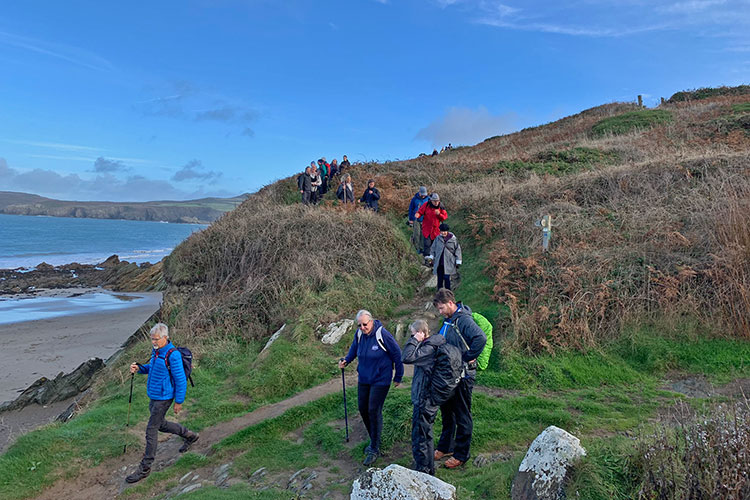
On Coast Path
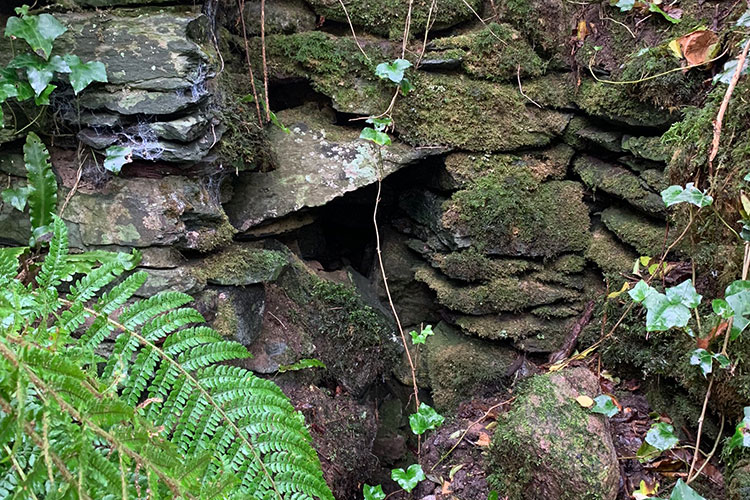
St Davids Baptismal Well
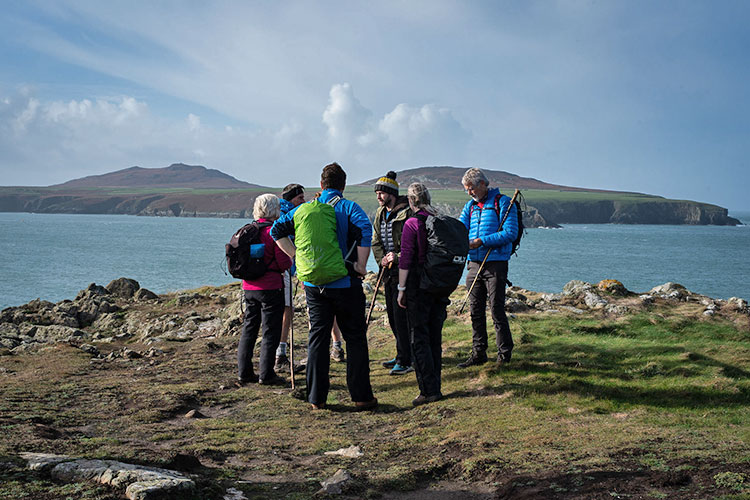
Ramsay Sound
Photo credit - Karel Jasper
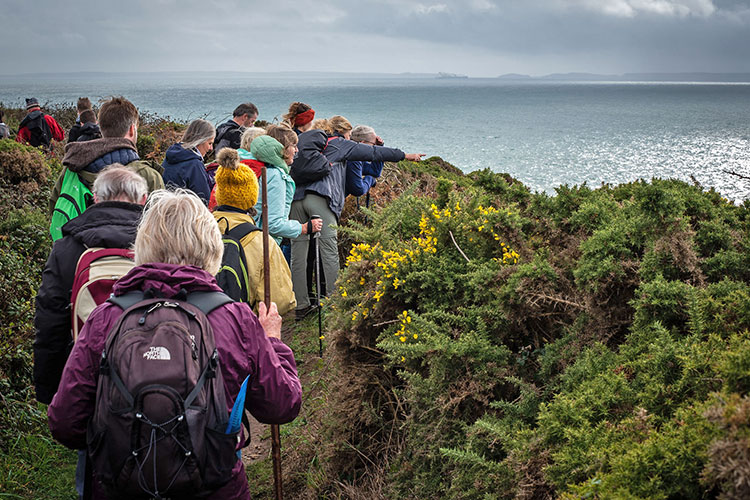
Dolphin Spotting
Photo credit - Karel Jasper
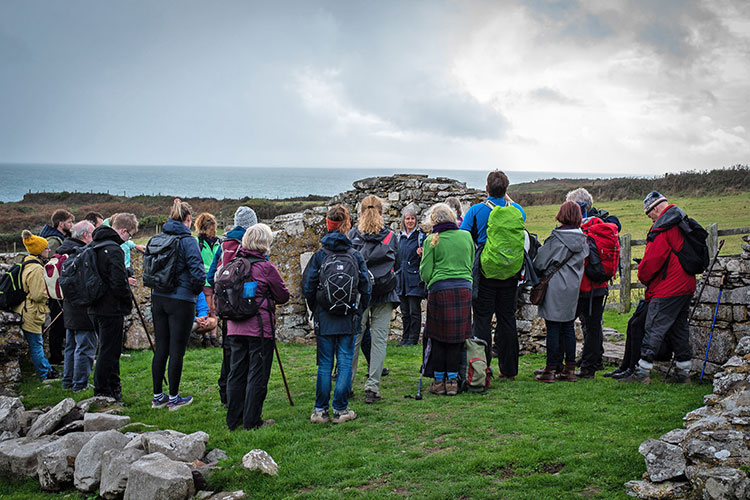
St Non's Chapel
Photo credit - Karel Jasper
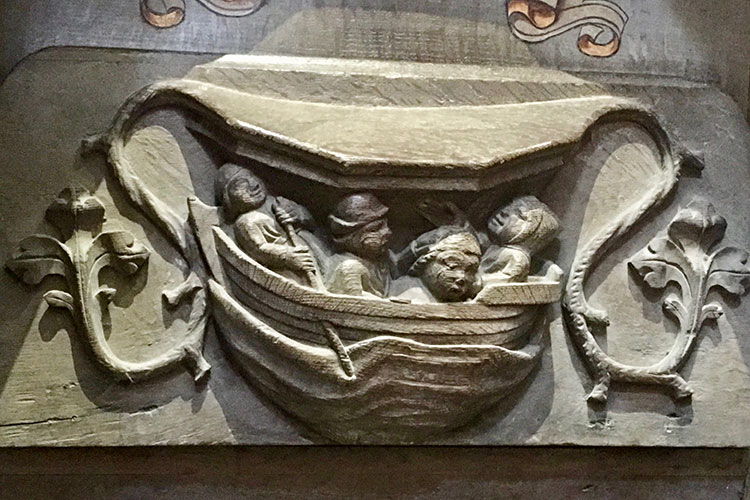
Misericordiae
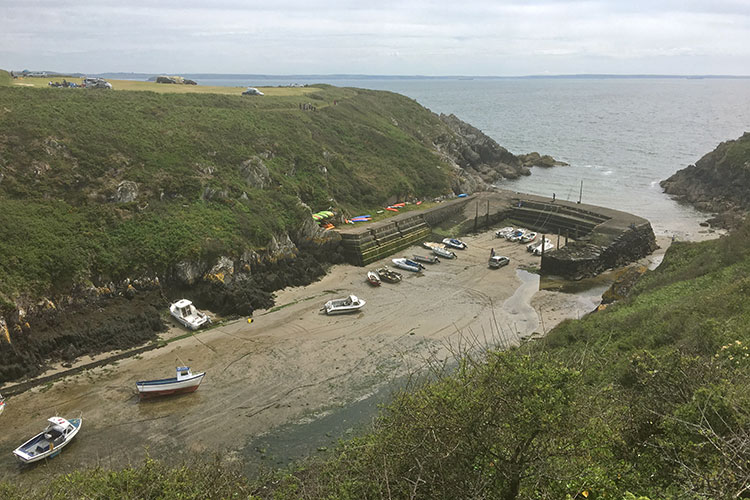
Porthclais Harbour
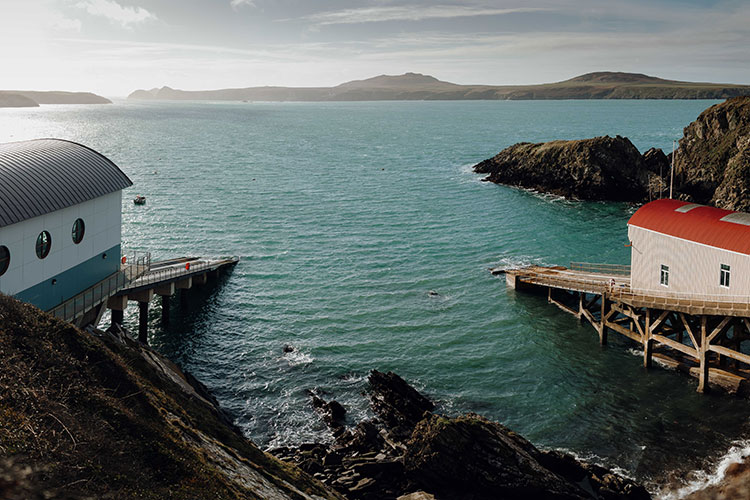
RNLI Station
Photo Credit - Celtic Routes
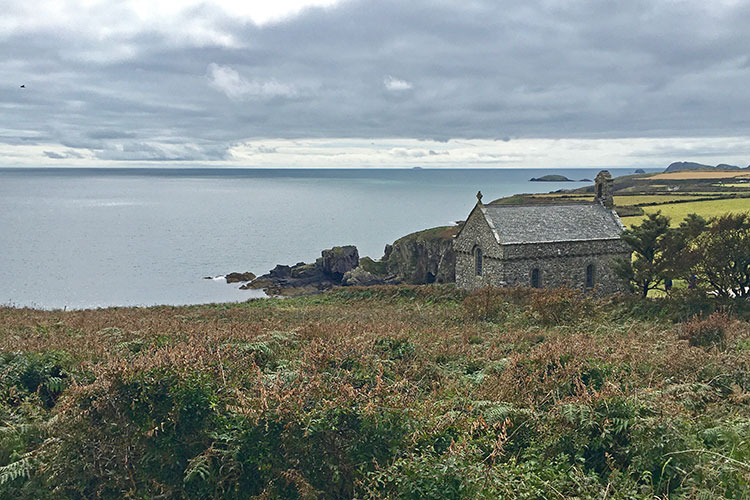
St Non's New Chapel
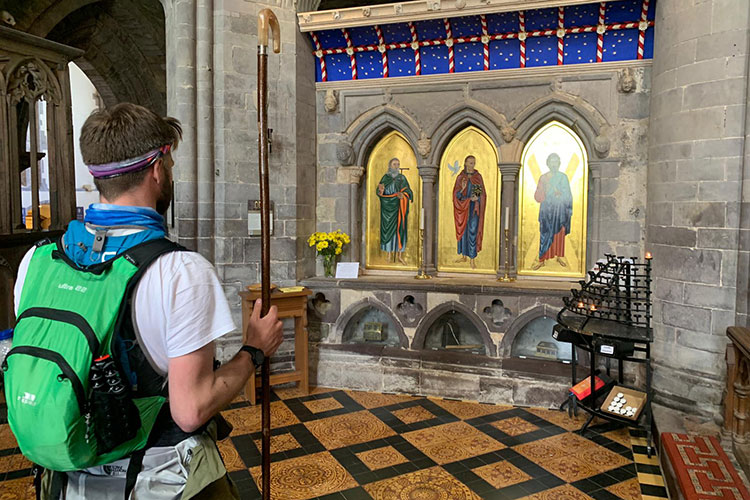
St David's Shrine
St David and Chief Boia
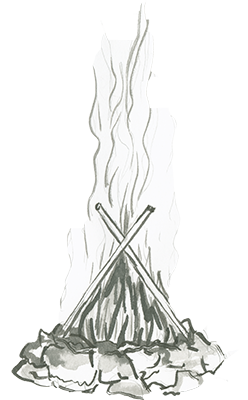
According to legend, St David was instructed by an angel to return to Pembrokeshire to establish a monastery. He and his friends, including St Aidan, celebrated their arrival home by building a large fire. Unfortunately for them, the fire was on the land of a feared Irish chieftain named Boia. He and his family lived in an old fort and were infamous for terrorising the surrounding lands. Boia was furious with this intrusion on his lands, and decided to lead his best warriors out to attack them. As they approached the holy men, a strange fever came over Boia and his men. They retreated to their fort but soon discovered all of their cattle and sheep were dead. Realising the power of the intruders, Boia returned to St David and humbly requested mercy. St David made peace with Boia and restored his animals to life, but only after Boia donated land for the new monastery.
Boia’s wife was furious when she heard this and tried to remove St David herself. She sent her female slaves to bathe naked, play suggestive games and use lewd words in front of the monks. The monks begged St David to leave lest they fall to temptation, but he refused and restored order by leading the monks in fasting and praying all night.
In a final act of defiance Boia’s wife sacrificed her step-daughter Dunawd to the pagan gods. When she realised the sacrifice had done nothing, she went mad and was never seen again. Boia decided to avenge his wife and daughter and prepared to attack St David again, but before he could another Irish chieftain invaded his land and beheaded him. Divine retribution continued; fire rained down from the sky destroying Boia’s settlement. Over 1,400 years later, when archaeologists came to excavate at Clegyr Boia, they found the charred remains of huts and storehouses.
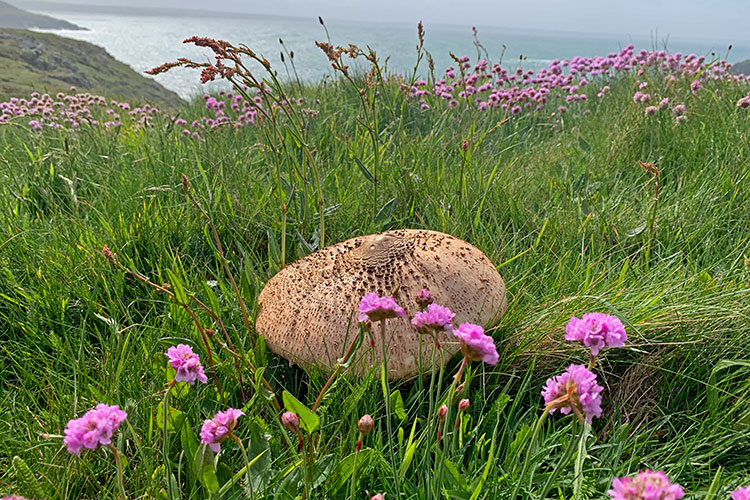
WILDFLOWERS
You will see a good variety of wildflowers along the Pembrokeshire path in all seasons. But they are particularly splendid in spring and early summer (April to June).
At various times, the path is lined with banks of thrift and sea campion, stonecrop, cowslip, kidney vetch. There is also the added bonus of rarieties such as spring squill and many more. When there is less variety of colour, the gorse and the heather present waves of yellow and purple.
There are various wildflowers associated with pilgrims such as a balm made from tormentil to ease sore feet, or plantain leaves in the shoes (probably sandals in earlier times) to stop blisters.
Sign up for our Newsletter
Be the first to know about guided events being offered along the route and all the latest developments as we head for a pilgrimage launch in 2023.

